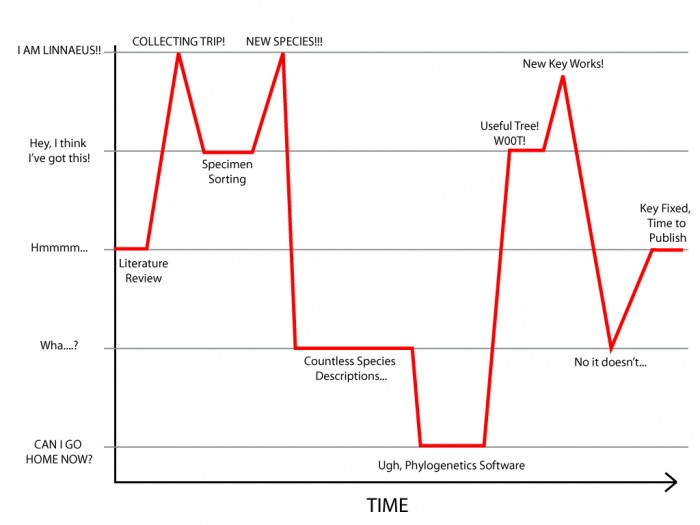The Geek In Question posted an awesome graph representing the stages and challenges of scientific publication. You should go check it out right now if you haven’t seen it yet, because it’s spot on! I’m right in the middle of the graph (you know, the big pit of despair part) on a couple of manuscripts currently, and am really looking forward to that beer-drinking phase!
Until then, I figured I’d join in and provide my take on the taxonomic process, which has it’s own series of highs and lows!
This may seem intimidating, but trust me, I love what I do and couldn’t imagine doing anything else with my life! I also might be exaggerating a little bit in some of those low areas (except for the phylogenetics software, that stuff blows), but nothing beats the highs of collecting, species discovery, and making your work accessible to the world!


I’m working in bioinformatics and I used to do evolutionary bioinfo, and seeing that you hate phylogenetics software, what kind of software do you use? What makes it so terrible?
I rarely get the chance to talk to non-bioinformatics-people, so I thought I’d ask!
Hi Philipp, thanks for stopping by. My relationship with phylogenetics software is certainly a love/hate kind of thing, i.e. I love it when it works, but hate the little bugs that stop analyses from working! I’ve used a combination of TNT, PAUP*, POY, MrBayes, and a variety of accessory programs necessary for stats and such. Each program has its own little quirks that have taken me quite a bit of time to work out and overcome, but all in all they work relatively well most of the time. It’s certainly a lot better than working out phylogenies by hand, so I don’t like to complain too much (I also do enjoy working out the kinks and learning some syntax from time to time, but don’t tell anyone)!
I don’t mind phylogenetic systematics software, if it’s not a black box. Had quite a bit of a time learning and using WinClada for morphological characters. But that software uses traditional parsimony cladistics. Bayesian analysis and maximum likelyhood both have hidden assumptions (e.g. the inevitable “where do priors come from?” question). Not to mention the mass usage of various sequence lengths without any a priori discrimination is practically phenetics. Not hating on molecular characters, of course. I have plans, oh yes, but I will do things differently…
Also, you can do the collecting. I enjoy being outside, but collecting is stressful for me. Would much rather be the person to sort the samples, identify specimens and describe new species.
But I agree that it’s really frustrating when a key doesn’t work. Glad I have a working Neartic keroplatid genera key /now/ (just wait though, the Orfeliini is a you-know-what when it comes to genera).
I sense a revolution shaping up here Kai! I look forward to seeing your ideas and your key. And no worries, I’d be happy to grab you some specimens if I get outside again!
Awesome Morgan, I can emphasize with this graph. I should show you my graph as of late. Definitely had a couple of “I AM LINNAEUS” moments swiftly followed up with “wha….”. :S
Good stuff…
Thanks Adam! Glad to hear the graph applies to taxonomists working around the world! lol
I like your posts about this piece and teaching etc. Did you remember we met last ESA meeting in Reno with Owen Lonsdale.
Thanks Li! I certainly do remember meeting you! I hope you enjoyed your visit to Ottawa!
Haha this graph is so accurate, thanks for picking me out of the purgatory known as phylogenetics programs…
Oh also I might be down a bit earlier next week, are you around? I would like to continue picking your brain for a while if you wouldn’t mind?
Don’t worry Miles, you’re not alone down there! lol
I’ll be around the lab all week, so whenever you’re in town feel free to stop in!